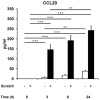The EGFR-ERK/JNK-CCL20 Pathway in Scratched Keratinocytes May Underpin Koebnerization in Psoriasis Patients
- PMID: 31936670
- PMCID: PMC7013594
- DOI: 10.3390/ijms21020434
The EGFR-ERK/JNK-CCL20 Pathway in Scratched Keratinocytes May Underpin Koebnerization in Psoriasis Patients
Abstract
Epidermal keratinocytes represent a rich source of C-C motif chemokine 20 (CCL20) and recruit CCR6+ interleukin (IL)-17A-producing T cells that are known to be pathogenic for psoriasis. A previous study revealed that scratch injury on keratinocytes upregulates CCL20 production, which is implicated in the Koebner phenomenon characteristically seen in psoriasis patients. However, the molecular mechanisms leading to scratch-induced CCL20 production remain elusive. In this study, we demonstrate that scratch injury upregulates the phosphorylation of epidermal growth factor receptor (EGFR) and that the specific EGFR inhibitor PD153035 attenuates scratch-induced CCL20 upregulation in an extracellular signal-related kinase (ERK)-dependent, and to a lesser extent, a c-Jun N-terminal kinase (JNK)-dependent but p38 mitogen-activated protein kinase (MAPK)-independent manner. Immunoreactive CCL20 was visualized in the keratinocytes that lined the scratched wound. IL-17A also induced the phosphorylation of EGFR and further augmented scratch-induced CCL20 upregulation. The EGFR-ERK/JNK-CCL20 pathway in scratched keratinocytes may explain why Koebnerization is frequently seen in psoriasis patients.
Keywords: CCL20; ERK; IL-17A; JNK; Koebner phenomenon; epidermal growth factor receptor; keratinocyte; p38 MAPK; psoriasis; scratch injury.
Conflict of interest statement
The authors declare no conflict of interest.
Figures







Similar articles
-
Cyto/chemokine profile of in vitro scratched keratinocyte model: Implications of significant upregulation of CCL20, CXCL8 and IL36G in Koebner phenomenon.J Dermatol Sci. 2019 Apr;94(1):244-251. doi: 10.1016/j.jdermsci.2019.04.002. Epub 2019 Apr 13. J Dermatol Sci. 2019. PMID: 31010609
-
Cyr61/CCN1 induces CCL20 production by keratinocyte via activating p38 and JNK/AP-1 pathway in psoriasis.J Dermatol Sci. 2017 Oct;88(1):46-56. doi: 10.1016/j.jdermsci.2017.05.018. Epub 2017 Jun 1. J Dermatol Sci. 2017. PMID: 28602508
-
Expression of IL-33 in the epidermis: The mechanism of induction by IL-17.J Dermatol Sci. 2013 Aug;71(2):107-14. doi: 10.1016/j.jdermsci.2013.04.014. Epub 2013 Apr 19. J Dermatol Sci. 2013. PMID: 23764374
-
Pathogenic implication of epidermal scratch injury in psoriasis and atopic dermatitis.J Dermatol. 2020 Sep;47(9):979-988. doi: 10.1111/1346-8138.15507. Epub 2020 Jul 16. J Dermatol. 2020. PMID: 32677165 Review.
-
Interleukin-17A and Keratinocytes in Psoriasis.Int J Mol Sci. 2020 Feb 13;21(4):1275. doi: 10.3390/ijms21041275. Int J Mol Sci. 2020. PMID: 32070069 Free PMC article. Review.
Cited by
-
Cobalt protoporphyrin promotes human keratinocyte migration under hyperglycemic conditions.Mol Med. 2022 Jun 23;28(1):71. doi: 10.1186/s10020-022-00499-0. Mol Med. 2022. PMID: 35739477 Free PMC article.
-
Expression profile of mRNAs and miRNAs related to mitogen-activated kinases in HaCaT cell culture treated with lipopolysaccharide a and adalimumab.Cell Cycle. 2024 Feb;23(4):385-404. doi: 10.1080/15384101.2024.2335051. Epub 2024 Apr 1. Cell Cycle. 2024. PMID: 38557266 Free PMC article.
-
Enhanced Fluctuations in Facial Pore Size, Redness, and TEWL Caused by Mask Usage Are Normalized by the Application of a Moisturizer.J Clin Med. 2022 Apr 11;11(8):2121. doi: 10.3390/jcm11082121. J Clin Med. 2022. PMID: 35456214 Free PMC article.
-
Significant Reversal of Facial Wrinkle, Pigmented Spot and Roughness by Daily Application of Galactomyces Ferment Filtrate-Containing Skin Products for 12 Months-An 11-Year Longitudinal Skin Aging Rejuvenation Study.J Clin Med. 2023 Feb 1;12(3):1168. doi: 10.3390/jcm12031168. J Clin Med. 2023. PMID: 36769815 Free PMC article.
-
Multi-target mechanism of Solanum xanthocarpum for treatment of psoriasis based on network pharmacology and molecular docking.Saudi Pharm J. 2023 Nov;31(11):101788. doi: 10.1016/j.jsps.2023.101788. Epub 2023 Sep 16. Saudi Pharm J. 2023. PMID: 37811124 Free PMC article.
References
-
- Ichiyama S., Ito M., Funasaka Y., Abe M., Nishida E., Muramatsu S., Nishihara H., Kato H., Morita A., Imafuku S., et al. Assessment of medication adherence and treatment satisfaction in Japanese patients with psoriasis of various severities. J. Dermatol. 2018;45:727–731. doi: 10.1111/1346-8138.14225. - DOI - PubMed
MeSH terms
Substances
Grants and funding
LinkOut - more resources
Full Text Sources
Medical
Research Materials
Miscellaneous

